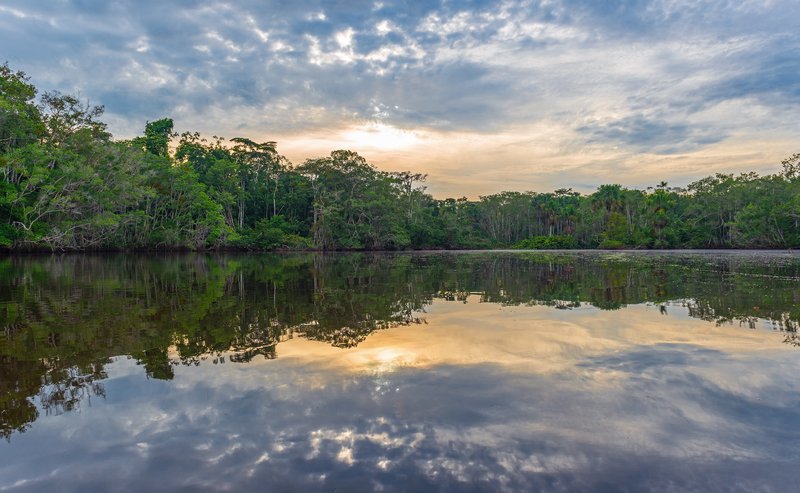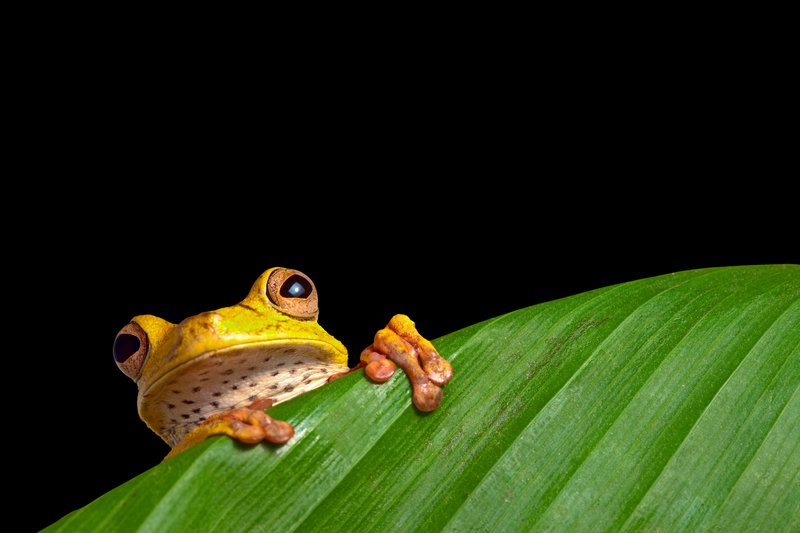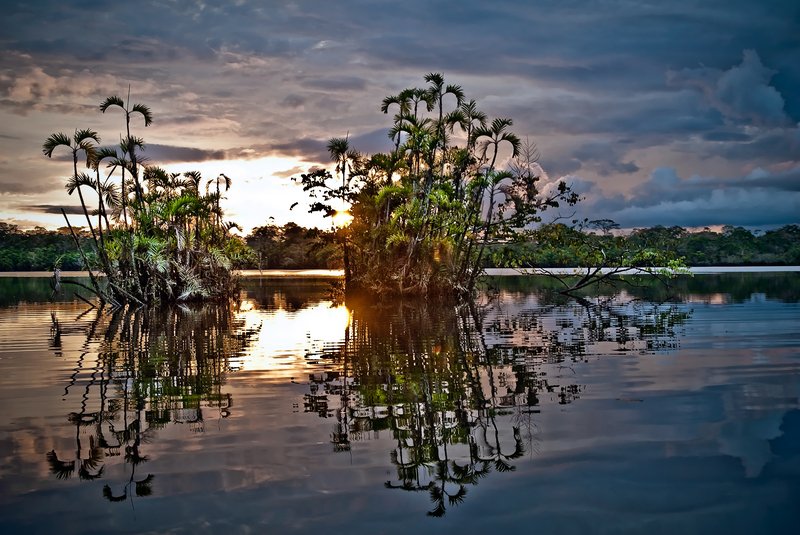Brazil is a beautiful country filled with bustling cities, pristine coastlines, and gorgeous rain forests, unlike those found anywhere else in the world. When visiting Brazil, checking out the rainforest is a must, but this can leave you wondering if it is safe to do so and if you need to know anything before you start packing your bags.
Generally, it is safe to visit the Amazon Rainforest if you go on an organized tour. However, there are still some risks to visiting the rainforest, and you should be aware of these risks before you embark on your trip.
To ensure you are properly prepared for your Amazon Rainforest adventure, keep reading to find out all about the Amazon Rainforest and the dangers and wonders concealed in its midst.
How Big is the Amazon Rain Forest?
The Amazon Rainforest is huge. It covers over 2.1 million square miles and touches eight different countries in South America. This means that there are country borders obscured in the rainforest itself. The Amazon Rainforest is also home to one-third of the planets living organisms.

Sixty percent of the Brazilian territory consists of the Amazon. This means that visiting the Amazon while in Brazil is very easy, and there are many areas to do so. However, this also means that visiting the rainforest isn’t a walk in the park. You will need specific plans to visit the rainforest and book with a company rather than wandering in.
How Dangerous is the Amazon Rainforest?
The Amazon Rainforest is known worldwide for its unique beauty and the ability to see creatures that you can’t see anywhere else on earth. However, this doesn’t mean that it is safe, and there are several dangers you need to be aware of.
As mentioned above, the Amazon is safe to travel to, as long as you are aware and prepared for the dangers which may present themselves. Below is a list of some of the most common dangers tourists encounter in the Amazon.
Illness
The biggest danger, reported by almost everyone who has had the ability to visit the Amazon, is getting some kind of illness. This is because rainforests are filled with bugs of every sort and breeding grounds for mosquitos. And the mosquitos in the Amazon carry Yellow Fever and Malaria—two diseases that can be quite deadly.
And if this weren’t enough, many tourists report catching illnesses from the food and water. So, of course, it would help if you did not drink any of the water in the Amazon, except that which comes in a sealed plastic bottle. But even if you are careful with the water, the naturally existing bacteria in the food you are eating may be different from your body at home, which can cause stomach upset.
Some stomach upset is normal, but if it continues for a long period of time, it can lead to dehydration which is a serious condition that can lead to death. This is the biggest risk you take when traveling to the Amazon, and it’s important to keep in mind the amount of water you will want to drink to keep yourself healthy.
Weather
After illness, the next biggest risk to travelers in the Amazon is the weather. This is because the weather can often be unpredictable in the rainforest, and it can cause a chain of events that can create dangers for travelers.
The biggest weather danger is the torrential downpours which can cause the river to rise rapidly and flood all of the channels that come from the Amazon river. These floods can wash out roads and create unfamiliar currents capable of sinking some of the most experienced boats.
Because these floods are so dangerous, most guided tours of the Amazon only occur during a certain part of the year when these heavy rains are less likely. Therefore, June through September tends to be the best months of the year to visit when trying to avoid heavy rains.
Wildlife
The whole reason you are headed to the Amazon is to see some amazing wildlife! But this wildlife can also be quite dangerous. Before you start imagining the danger of jaguars, alligators, and piranhas, which do exist in the Amazon, you should know that the real dangers you are facing will be much smaller.
As we mentioned earlier, your biggest (and smallest) animal enemy in the rainforest is the mosquito, which carries many illnesses. But after that, you actually need to be more worried about leeches than any other creature. The Amazon has large populations of the Tryannobdella Rex, a species of leech that is deadly to humans.
Even if you avoid the water and other places where pesky leeches could hide, you also have to worry about venomous snakes and frogs. These small animals can hide out in the underbrush, leading you to come into contact with them unexpectedly.

Frogs can be especially dangerous because even the poisonous ones may look cute to the unsuspecting tourist. In general, you should know in advance not to touch any of the creatures you come across. This includes plants as well, as although most plants aren’t dangerous, there are some in the Amazon poisonous to humans.
If you’re starting to panic, don’t, as cases of animal attacks are quite rare in the Amazon. And the first step to avoiding poisonous creatures is to be informed and aware that they are there so that you know what to look out for.
What Do You Need to Survive the Amazon Rainforest?
If you haven’t been scared off just yet, then it’s time to learn about some of the things you will need to enjoy your Amazon adventure. If you collect all the things on this list and take the utmost caution, you’ll surely be able to enjoy a trip to the Amazon without mishaps.
Vaccines
Again, mosquitos are some of your biggest enemies in the entire rainforest. Therefore, you will want to be sure you have an up-to-date yellow fever vaccine and take malaria pills as instructed before you go. This will help protect you on your journey from most diseases carried by mosquitos.
Please speak with your doctor before you go, as they may have some additional vaccines to recommend. For example, when going to South America, many doctors recommend a hepatitis A vaccine that can help protect against one of the biggest causes of stomach upset on the continent.
Doctors may also recommend additional vaccines for the area, such as rabies, typhoid, and hepatitis b. You’d want to carry proof of all your vaccines on you, and be sure you let your tour guide know where to find your information if you were to be too hurt or ill to provide it.
Bug Spray
Just because you are vaccinated against yellow fever doesn’t mean you want to let the bugs have their way. Be sure to bring plenty of bug spray to protect yourself against their bites. Additionally, botflies are common in the Amazon, and if it lays eggs on you, the results can be disastrous (and gross), so be sure to get a bug spray that protects against botflies as well.
Wear Boots and Pants
Although it will probably be quite warm and humid when you visit, you must wear pants and boots at all times. This will again protect you from insect bites, as well as keep other critters like spiders and snakes away from your feet and ankles.
Just be sure that you check your boots every morning before putting them on just in case something crawled in while you were sleeping.
Anti-Itch Cream
If you get bitten by something, the last thing you want to do is scratch and cause an open wound on yourself, which can lead to bigger problems. So be sure to pack plenty of anti-itch creams as well as some sort of wound cleaner like Neosporin to keep all your wounds clean, clear, and disinfected.
A Mosquito Net
Suppose you are camping while in the Amazon Rainforest. You will definitely want to grab a mosquito net to bring with you. Even if you aren’t camping and are staying on a river cruise instead, a mosquito net can be an invaluable tool to keep the bugs away at night.
A Flashlight or Headlamp
Even if you are planning to hike during the day, there are places in the rainforest where trees almost completely obscure the sun. This means that you will want to bring light to be sure you can avoid stepping on a creature you would rather not. You’ll also enjoy being able to see where you are going as well.
Sunscreen and a Hat
The sun can be quite powerful in South America, and even if you think you are used to the sun, a day on the river can have you fried to a crisp in a minute. So bring a hat with a wide brim to protect your face, as well as sufficient sunscreen for your entire trip. Be sure to reapply frequently.
It is also good to bring after sun cream or aloe vera for that spot you will inevitably miss with sunscreen.
Binoculars
As mentioned in the previous section, you will want to avoid getting too close to the wildlife in the Amazon. But of course, this is also probably the whole reason you are there! So invest in a good pair of binoculars to take with you to see the sights and animals from a safe distance.
Bottled Water and Water Purification Tablets
Once again, you will want to avoid drinking the water while in Brazil. If you are in a city or on tour, you will likely have regular access to bottled water that is safe for you to drink. However, if you are planning on trekking and camping, it’s best to invest in a water purification bottle or tablets to be sure that you can make any water you come across safe for you to drink.
Imodium and Other Over the Counter Drugs
Imodium is an over-the-counter drug known for its ability to help those suffering from diarrhea. And if you’re in the middle of the rainforest, this can be a real lifesaver. But, of course, you’ll also want to bring things like ibuprofen and basic first aid supplies with you as well.
This is also something that you will want to discuss with your doctor before you go, as they can help you pick out other essential over-the-counter drugs that you may need while on your Amazonian journey. They can also make sure that whatever you pick is safe for you to take.
Is it Safe to Swim in the Amazon River?
When planning a trip to the Amazon, you’ll probably read about how hot and humid it is. This can leave you thinking that it might be nice to take a dip in the Amazon waters when the temperature gets high.
Unfortunately, this is not a good idea, as the waters are filled with leeches, alligators, and piranhas. This doesn’t mean that you can’t swim in the Amazon, though, because you can. Certain parts of the river are safe for swimming. It is best to ask the locals where these places are.

That being said, the water of the Amazon river is a murky brown color, and the water is warm year-round. This means that it will not be as refreshing as you think it might be, and just taking a look at the light brown-colored water might be enough for you to decide you’d rather not risk the dangers of swimming in the water of the Amazon.
Can You Call Emergency Services from the Amazon?
Another reason Amazon is so dangerous is that it is completely off the grid. So once you are walking around and exploring underneath the canopy of trees, you can assume that you will have zero cell service.
This is another reason it is so important to go on an organized tour. An organized tour guide will usually have a way to radio for help, such as by walkie-talkie or maybe a satellite phone. Additionally, they will know the area and terrain and be sure that you won’t get lost.
Although it wasn’t mentioned in the necessities list, it is good to have travel insurance for a trip to the Amazon. This is mainly because of the prevalence of food-borne illnesses in the region. So even if you don’t suffer a serious mishap (and hopefully you won’t), it can be nice not to worry when you want to have a certain bug bite or stomach symptom checked out.
Do You Need to Speak Portuguese to Visit the Brazilian Rainforest?
When traveling to another country where they speak a different language, communicating is always a concern, and the Amazon in Brazil is no different.
If you book a tour, you will clearly be with a guide that speaks the language the entire time. This is a good thing because although many Brazilians in the cities in touristy areas speak English, once you venture out into the Amazon, you should be prepared for people to only speak Portuguese or another indigenous language.
This doesn’t mean you have to learn the entire language before going, as a few words to help you in a bind will probably suffice. Just be prepared mentally to encounter people who speak not a word of English and have some hand motions and pointing ready to go.
Is There a Risk of Robbery in the Amazon?
Just like when you go on any vacation, you will always want to keep a close eye on all of your belongings. However, it is highly unlikely that you will get robbed in the Amazon. You are much more likely to be robbed in a larger city or the airport than you are while trekking through the rainforest.
If you are the victim of a robbery, it is best to let the thief have any of the items they are trying to steal. This is because it is not uncommon for robberies to turn violent. Also, be sure to take a copy of your passport with you and keep it in a separate place from your passport. This way, you will get a replacement if your passport is stolen.
Final Thoughts
Overall, visiting the Amazon Rainforest in Brazil can be a safe and amazing experience. However, you need to be sure that you are informed of and prepared to face all the dangers of this unique and beautiful land.
So schedule your vaccinations, pack all the essentials, and brush up on your Portuguese because your journey to Brazil is right around the corner! And whatever you do, don’t forget that bug spray!
While you’re here, I think we might interest you with these:
Where Is The Pantanal Exactly? Not in the Amazon Forest – It’s a very common mistake to think the Brazilian Pantanal is located in the Amazon, but it’s not! Click and find out where it is actually located!
A Backpackers Guide To Brazil – Wanna know all the details about backpacking in Brazil? We have all the important info right here!
5 Great Places for Fishing in Brazil – Brazil is a great place for fishing with its rich and diverse fauna. With that in mind, we listed the 5 best places to go fishing while in the country!
Cover Photo: boat swimming through the Amazon River – Credit: ID 177556709 © Anna Artamonova | Dreamstime.com
